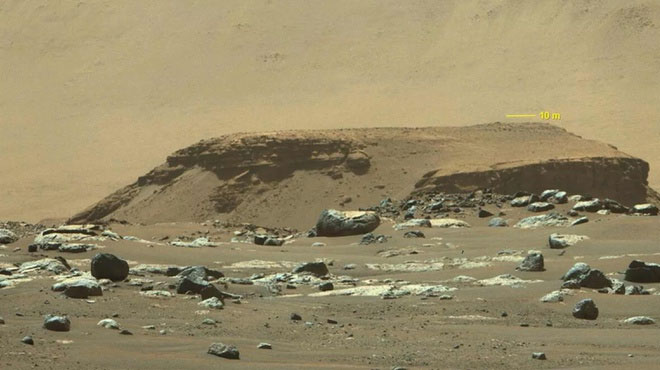New evidence of life on Mars discovered
Geologists say an area in the delta near the Perseverance probe may contain fossil evidence of extraterrestrial life.
In the study, published October 7 in the journal Science, geologists analyzed images taken by the Perseverance probe, which depict how water flowed on Mars billions of years ago.
The study has revealed an area on Mars that may contain biosignatures , which scientists have been looking for for years.

Perserverance's view of the Jezero crater towards the delta. (Photo: NASA).
Mars was once covered with rivers of water similar to Earth, which is also a sign of life. However, the large pools of water on Mars were dry for decades before the atmosphere disappeared. Since then, Mars has become a barren, inhospitable land.
Scientists have been studying the existence of water on Mars for many years. That's why the US Space Agency (NASA) launched the Mars 2020 exploration mission, using the Perseverance probe to search for traces of life on the "Red Planet".
According to CNET, Perseverance's exploration site around the Jezero crater , which is believed to have been flooded by water, is surrounded by a delta plain that may contain traces of life. The sedimentary layers of the delta are one of the important research targets, helping to find traces of ancient life.
"We all know that water once flowed on the surface of Mars, but it is not possible to determine how long," said Nicolas Mangold, a geologist at the University of Nantes (France) who authored the study.
For this purpose, the researchers wanted to analyze the delta of Jezero. Through images taken by Perseverance, scientists not only analyzed the main plain of Jezero but also observed a hilly area called Kodiak , part of the further delta.
"You can imagine the plains extending a bit south and east, but the erosion has taken some of the material away. It's amazing that Kodiak is still there , " Mangold said.

The Jezero Crater Plain area captured by the Mars Reconnaissance Satellite. (Photo: NASA).
"By analyzing Kodiak's stratigraphy, we were able to identify potentially life-preserving traces , " said Mangold, who was surprised to see the first image of large rock formations that shouldn't have been. sometimes a delta is not intact.
According to Mangold, the rocks show the Jezero Delta in the Gilbert style, formed by strong currents such as waves or tides. The team thinks that the river's flow suddenly became stronger, possibly due to climate change.
"This suggests that there is a lake at Jezero crater. In addition, the change in the horizontal bed structure to the fault indicates the water level in the area in the past , " the team said. Hangold's team suggested that Kodiak's deeper layers may have consisted of silt and sand, a sediment containing life-sustaining organic molecules.
According to Mangold, the team's goal is to send people to Mars, using the aircraft to approach and analyze the fault locations of the Kodiak Hills in the future.
- Discover the best location to search for life on Mars
- Discover more evidence of life on Mars
- Aliens may have been on Mars 3.8 billion years ago
- More evidence of life on Mars
- More evidence that Mars had life
- Could NASA have discovered and accidentally destroyed evidence of Mars on organic matter?
- There is evidence of life on Mars 4 billion years ago
- Evidence of Mars contains enough oxygen to support life
- Evidence shows that Mars has life
- Important evidence shows that Mars is more likely to have life
- Discovered ice on Mars
- More evidence of water on Mars
 Announced 3 houses on the Moon and Mars
Announced 3 houses on the Moon and Mars Science proves: Mars also knows 'deflated'
Science proves: Mars also knows 'deflated' Elon Musk announced the price for a Mars trip was 11.6 billion VND, free of charge
Elon Musk announced the price for a Mars trip was 11.6 billion VND, free of charge NASA discovered strange 'gate' on Mars, is the hiding place found?
NASA discovered strange 'gate' on Mars, is the hiding place found? Revealing the first city on Mars, with enough space for more than 250,000 people to live
Revealing the first city on Mars, with enough space for more than 250,000 people to live  We could start building a colony on Mars with just 22 people!
We could start building a colony on Mars with just 22 people!  Amazing discovery of 4.5 billion year old alien ocean of life
Amazing discovery of 4.5 billion year old alien ocean of life  Mars' Surprising Effect on Earth's Oceans
Mars' Surprising Effect on Earth's Oceans  Was there nuclear war in ancient times?
Was there nuclear war in ancient times?  What happens to dead bodies on Mars?
What happens to dead bodies on Mars? 